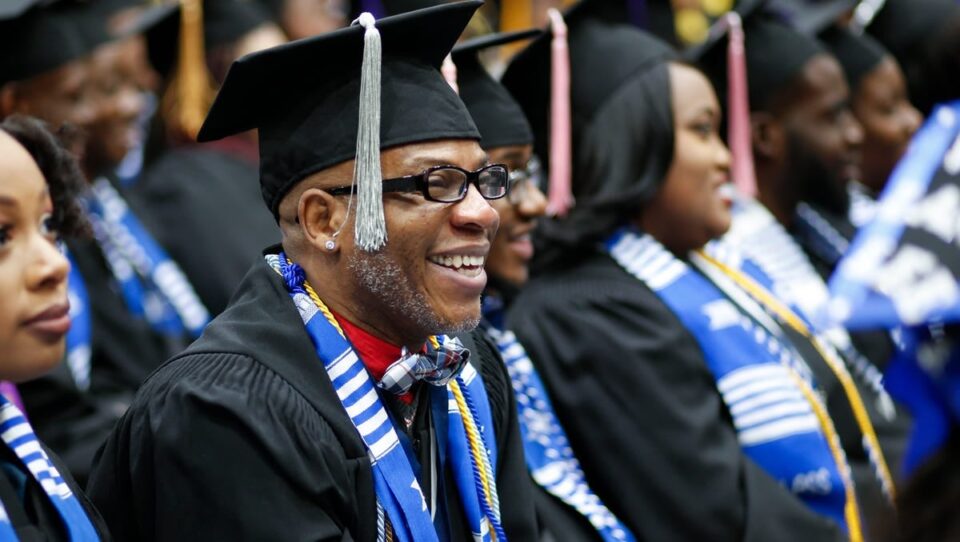Advanced J-Degrees Don’t Mean Higher Salaries
Hampton J-School Gets New Interim Dean
Blacks Feel Brunt of Police Tips to Landlords
Cops Said to Falsely Label Some as Gang Members
Biles Says IndyStar Made Her Realize Abuse
Which Hispanic Stories Will Be Told This Month?
Defiant Afro-Cuban on Time’s ‘Influential’ List
Taliban Apology to Journalists Rings Hollow
This Arab American Doesn’t Want to Be Called White
Broadcasters Say FCC’s Own Rules Limit Diversity
Short Takes: Sarah Goo and Aja Whitaker-Moore; Donald Trump and white evangelicals; Julio Vaqueiro; Atlanta Journal-Constitution initiative on Black topics; white executives prevail in Hollywood; new BET Studios for Black creatives; HBO Max initiative on Black storytelling; NAB PSAs on importance of fact-based journalism; CPB grants for “Urban Alternative” formats;
Averi Harper and diversity in ABC political coverage; “A People’s History of Black Twitter”; Ishmael Reed; new Ida B. Wells statue; Los Angeles pioneer status in residential segregation; Carmen Fields; Gillian B. White; “The Activist” reality show; “Tips for Reporters Seeking to Reveal the Scale of Inequality”; Lynsey Chutel; beating in Congo; jailing in Myranmar.
Homepage photo: Graduates at Jackson State University in Jackson, Miss., which offers a master’s program in mass communication. (Credit: MIssissippi Clarion-Ledger)
Support Journal-ismsAdvanced J-Degrees Don’t Mean Higher Salaries
“News reporting has lost thousands of jobs over the past decade, with a further slide predicted (paywall),” Melissa Korn and Anthony DeBarros reported Sept. 10 for The Wall Street Journal. “Yet, journalism schools continue to churn out heavily indebted master’s degree graduates hoping to find a footing in the cratering industry.
“Many students leave even the most prestigious private graduate programs, such as those at Northwestern University, Columbia University and the University of Southern California, with earnings too low to let them make progress paying off their loans, according to a Wall Street Journal analysis of Education Department figures released this year.
“At Northwestern, students who recently earned a master’s degree in journalism and took out federal loans borrowed a median $54,900 — more than three times as much as their undergraduate counterparts did. That is the biggest gap of any university with available data. Worse still, the master’s degree holders make less money. Early-career earnings for those with master’s degrees in journalism from Northwestern are about $1,500 lower than for its undergraduate students, data show. . . .”
Korn and DeBarros also wrote, “Charles Whitaker, who has been Medill’s dean since 2019, declined to say how much the school awards each year in scholarships for master’s students, but called the pool limited and said fundraising for the aid is challenging. Northwestern is among the wealthiest universities in the U.S., with an $11.1 billion endowment; the school doesn’t break out how much of that is available for the journalism program to tap.
“ ‘Graduate student debt is the thing that keeps me up at night,’ Mr. Whitaker said. He attributed some of the earnings differential to the fact that undergraduates often complete their degrees with multiple internships and years of experience on student publications.
“At the graduate level, Mr. Whitaker said, ‘We take bright French majors and try to turn them into journalists in 12 months.’
“The number of journalism master’s degrees awarded annually in the past few years by Medill has been between 120 and 140, down from about 185 a decade ago.
“Mr. Whitaker said that employers are partly to blame for journalism graduates’ poor financial outcomes, and that he tells news-industry leaders, ‘I cannot in good conscience encourage students to go into this kind of debt if you cannot pay better.’
 “Michael Days (pictured), a former editor of the Philadelphia Daily News and past president of the News Leaders Association, said employers can’t do much more.
“Michael Days (pictured), a former editor of the Philadelphia Daily News and past president of the News Leaders Association, said employers can’t do much more.
“ ‘Smaller papers just don’t have the ability to pay really high salaries,’ he said, adding that it is a moment of existential crisis in the field. ‘The industry’s still trying to figure out what it is going to be in the digital world, how it is going to go beyond survival’. . . .”
 Mary A. Bock (pictured), adviser to the overall master’s program at the University of Texas at Austin, School of Journalism and Media, considered an Hispanic-serving institution, contends the master’s is worth it.
Mary A. Bock (pictured), adviser to the overall master’s program at the University of Texas at Austin, School of Journalism and Media, considered an Hispanic-serving institution, contends the master’s is worth it.
She messaged Journal-isms, “I do believe that our professional MA provides world-class preparation for journalists and that as a public institution we are able to do so far more economically than other universities. Our students go on to careers with national and local news institutions whether they write, shoot video, or work as photojournalists.”
Hampton J-School Gets New Interim Dean
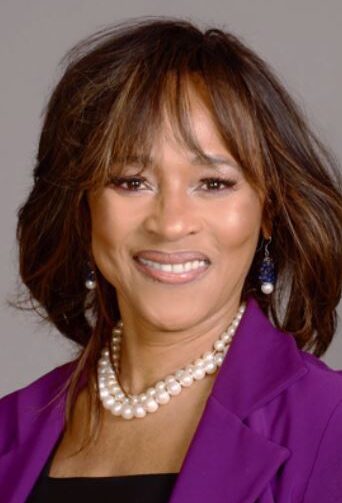 Julia Wilson (pictured), founder of a global communications and public relations firm who joined Hampton University as an adjunct professor only this year, has been named interim dean of the Scripps Howard School of Journalism and Communications — and she says she’s acting as if the “interim” isn’t in the title.
Julia Wilson (pictured), founder of a global communications and public relations firm who joined Hampton University as an adjunct professor only this year, has been named interim dean of the Scripps Howard School of Journalism and Communications — and she says she’s acting as if the “interim” isn’t in the title.
The previous dean, B. Da’vida Plummer (pictured, below) left to join “the leadership team of a global non-profit” based in New York, Plummer told Journal-isms, adding that the firm would make an official announcement.
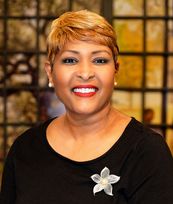
Wilson’s appointment follows the appointment of deans Jackie Jones at Morgan State University’s School of Global Journalism and Communication in June, and that of Mira Lowe at FAMU’s School of Journalism & Graphic Communication last month, all historically Black institutions.
The Sept. 1 news release about Wilson said, “In addition to managing a 40-member network of Historically Black Colleges and Universities (HBCUs), the HBCU-China Network student study abroad program, Wilson oversaw the English-Mandarin translation of Hampton University President Dr. William R. Harvey’s book, ‘Principles of Leadership: The Harvey Leadership Model,’ and launched the book at the 2018 Beijing International Book Fair.“
She also promoted Dorothy Butler Gilliam’s 2019 memoir, “Trailblazer: A Pioneering Journalist’s Fight to Make the Media Look More Like America.“
The HBCU-China Network is a consortium of 42 historically black colleges and universities formed in 2014.
Wilson said Friday that she plans to build upon her experience with the China program, which included Hampton students, to bring more of an international focus to the journalism program. She also said, “I want our students to compete with the major schools” teaching journalism — not just HBCUs — so that “they can compete with anybody in the world. That’s my vision,” she said.
Wilson taught remotely on international affairs last semester but appeared only two days in person this semester before being tapped as interim dean, she said.
Hampton students are back on campus. All students must be vaccinated and there is mandatory masking on campus, she said. “Protocols also include weekly COVID tests for athletes,” the Virginian-Pilot in Norfolk reported last month.
Plummer served 9½ years at Hampton, holding the positions of associate professor, director of the William R. Harvey Leadership Institute, assistant vice president for marketing/media and, for five years, dean.
Asked what she considered her biggest accomplishments, Plummer messaged, “Transforming the broadcast journalism area of study into a recognized top producer of content creators. The top brands look to SHSJC for high caliber line producers and entry-level MMJs [multi-media journalists]. As I prepared to leave, it was gratifying to note the renovations and upgrades to the facility including a brand new virtual reality lab, new computers, cameras and remote equipment.
“BUT— the biggest moment was that last humbling embrace from students who openly expressed that I had made a difference,” referring to a surprise student tribute to her Aug. 31, captured on video. (see below)
(Video credit: Butch Maier/Sumbadhat Productions)
The Scripps school opened in 2002 in a $5.7 million building funded by the corporate foundation of the E.W. Scripps Co. It has about 350 students.
- Kristen Broady, Andre M. Perry and Carl Romer, Brookings Institution: Underfunding HBCUs leads to an underrepresentation of Black faculty (Aug. 4)
- Curtis Bunn, NBC: A new book makes the case that HBCUs are owed reparations (Aug. 19)
- Shawna Chen, Axios: Historically Black Colleges and Universities face a cultural identity crisis (Aug. 21)
- Howard University News Service: Truth and Service Classic Brings Howard and Hampton Together for Football, Fun (video)
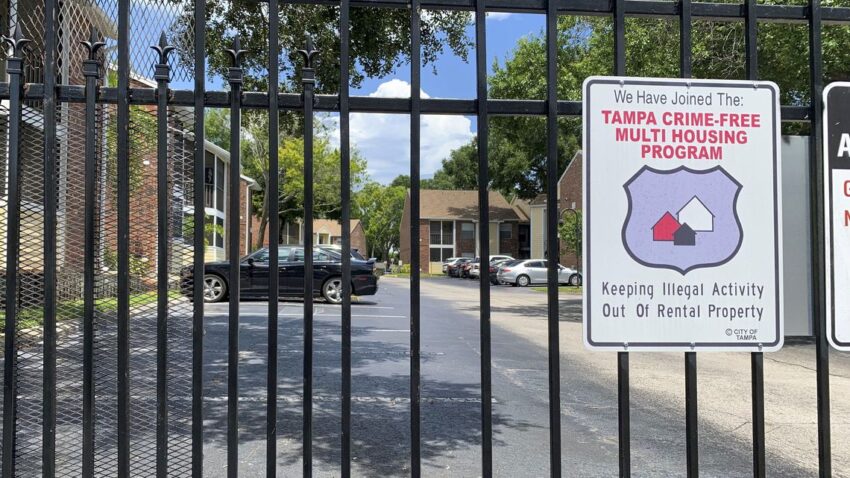
Blacks Feel Brunt of Police Tips to Landlords
Tampa, Fla., Mayor Jane Castor announced Saturday that the city will reform its Crime-Free housing program, Christopher O’Donnell reported for the Tampa Bay Times. “The move comes four days after a Tampa Bay Times investigation revealed how officers encouraged landlords to evict tenants based on arrests, including some where charges were later dropped. The investigation was published online Wednesday at Tampabay.com.”
O’Donnell, Ian Hodgson and Nathaniel Lash reported then that,” since 2013, “the Tampa Police Department has taken a hands-on role at more than 100 apartment communities, sending notices to landlords when their tenants are arrested or stopped by officers and encouraging their eviction.”
“The program, known as Crime-Free Multi Housing, was marketed to landlords as a way to keep violent crime and drug and gang activity off their properties.
“Police pledged to create a database of ‘documented violent offenders, gang members or career criminals involved in your community.’ It alerted landlords to tenants arrested for armed robbery and drug dealing.
“But the program also swept up more than 100 people who were arrested for misdemeanors — and dozens more whose charges were later dropped, a Tampa Bay Times investigation has found.
“Tenants were reported to their landlord for matters as small as shoplifting; two were reported for driving with a suspended license. Entire families lost their homes after the arrest of a child or a relative who didn’t live with them.
“And roughly 90 percent of the 1,100 people flagged by the program were Black, police records show. That’s despite Black residents making up only 54 percent of all arrests in Tampa over the past eight years. . . .”
“Black renters bore the brunt of the program’s impact. Almost 86 percent of those flagged in the database and 91 percent of those named in letters to landlords were Black, records show.
“The racial disparity is no accident. Tampa has 267 apartment complexes of 15 or more units, but only about 100 complexes were enrolled in the program at its peak. Three-quarters of those were in neighborhoods where U.S. Census block data shows the majority of residents are Black and Hispanic, the Times found. . . .”
O’Donnell reported Saturday, “Under the announced changes, the city will inform landlords only about ‘certain serious drug and violent felonies.’ A police captain must sign off on notices sent, and landlords will be notified only about arrests that happen on their properties. . . .”
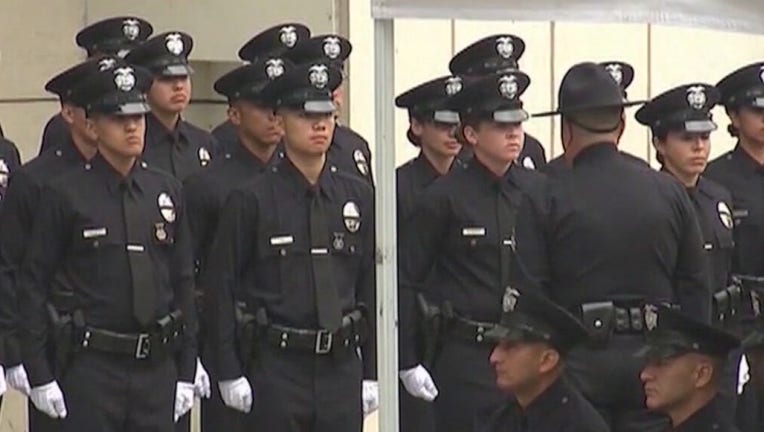
One Los Angeles police officer filed a civil lawsuit saying an unspoken quota system put pressure on Metro officers to identify gang members regularly.
Cops Said to Falsely Label Some as Gang Members
“At least four more Los Angeles police officers are suspected by prosecutors of putting false gang information on field interview cards, according to an internal record from the L.A. County district attorney’s office,” Kevin Rector reported Wednesday for the Los Angeles Times.
“The claims bring the total number of Metropolitan Division officers suspected of inputting false information on such cards to 10. The six others were criminally charged in the case last year; each has pleaded not guilty. . . .”
Rector also wrote that one officer “filed a civil lawsuit last year alleging she was targeted amid the broader gang-labeling scandal — and taken off the streets — because commanders feared she would blow the whistle on an unspoken quota system that put pressure on Metro officers to identify gang members regularly. . . .”
Rector added, “The document from [District Attorney George] Gascón’s office, obtained by The Times through a public records request, was drafted to explain prosecutors’ decisions not to file charges against 19 other officers whose actions had also come under review as part of the broader investigation.
“It provided the latest accounting of a sprawling investigation that was sparked in 2019 after a Van Nuys mother challenged the gang classification of her son. LAPD supervisors found inconsistencies between the officer’s account and body-camera video of the stop, and a broader probe was launched. . . .”
Olympic gymnast Simone Biles ripped the FBI and the Justice Department in Senate testimony Wednesday for how FBI agents mishandled abuse allegations brought against Larry Nassar and then made false statements in the fallout from the botched investigation. (Credit: CNN via YouTube)
Biles Says IndyStar Made Her Realize Abuse
“As Simone Biles delivered stirring testimony before a Senate committee about her abuse at the hands of the doctor Larry Nassar, she blamed a system that failed to protect her and later kept her in the dark, even as she competed at the summer 2016 Olympics in Rio de Janeiro,” Elahe Izadi reported Friday for The Washington Post.
“In fact, the Olympian said, ‘I didn’t understand the magnitude of what all was happening until the Indianapolis Star published its article in the fall of 2016 entitled “Former USA Gymnastics doctor accused of abuse.” ‘
“That article — in which former gymnast Rachael Denhollander publicly accused Nassar of abuse — was part of an investigative series from the Indianapolis newspaper called ‘Out of Balance.’
“The project, which brought accountability where there had been none, all began with the Star acting swiftly on a tip. . . .”
-
Sono Shah, Pew Research Center: Simone Biles by far the most-mentioned Team USA athlete on Twitter during Tokyo Olympics
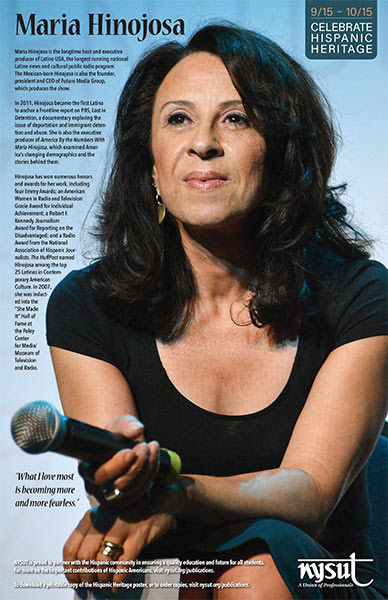
Veteran journalist Maria Hinojosa, president of the Futuro Group, producer of public radio’s “Latino USA,” is featured on a poster for Hispanic Heritage Month. (Credit: New York State United Teachers)
Which Hispanic Stories Will Be Told This Month?
In the effort to make Hispanic Heritage Month more palatable or commercially viable, are stories of oppression, prejudice and injustice whitewashed or ignored?
That’s one of the questions raised by Vanessa Romo of NPR in a story Friday about the monthlong commemoration, which began Sept. 15.
” ‘Too often the focus is on the musical contributions or dancing or other happy artforms,’ Mario T. Garcia, professor of Chicana and Chicano Studies at the University of California, Santa Barbara, tells NPR.
” ‘But we also need programming that reflects historical problems … because you can’t assume that Latinos already know about the lynchings in South Texas in the 1910s,’ the Zoot Suit Riots, the segregation of Mexican kids in schools, or the Chicano-led high school walkouts of the 1960s that permanently changed higher education enrollment for Latino students.
“In his experience, Garcia notes, the U.S. public education system does such a poor job of teaching the history of Latinx people in this country, that often Hispanic Heritage Month is the only opportunity for any students to learn about it. ‘It is a real shame,’ he says.
“But approached in the right way, he adds, even these stories can be ultimately seen as happy. ‘Because the historic struggles of Chicanos, Mexican-Americans, other Latinos are happy stories … because only through those struggles have we been able to achieve more social justice in this country, more education.’ “
- Ana Arana, Poynter Institute: How a community-focused weekly is punching holes in an Illinois town’s political discourse: The Cicero Independiente is bringing politics into the open in Latino-majority Cicero, Illinois.
- Claudia Romo Edelman, Adweek: Hispanics Are Keeping the American Dream Alive — Listen to Their Voices
- Bryan Fonseca, Latino Rebels: We Haven’t Paid Much Attention to Jasmine Camacho-Quinn’s Amazing Statement on Identity
- Jean Guerrero, Los Angeles Times: More than a ‘nameless maid’: A memoirist’s manifesto on Latinx colorism (Sept. 9)
- Pedro Alfonso Trevino, Jr., Latino Rebels: Equally Unequal: The Exclusion of Latino Jurors
- New York State United Teachers: Hispanic Heritage poster honors Maria Hinojosa
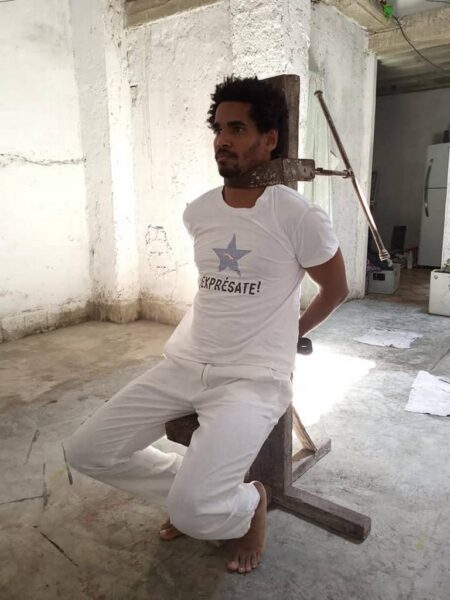
Cuban performance artist Luis Manuel Otero Alcántara, named by Time magazine as one of the year’s iconic figures, is pictured in April staging his protest art at his Havana home while under government surveillance. (Courtesy via Miami Herald)
Defiant Afro-Cuban on Time’s ‘Influential’ List
“1619 Project” journalist Nikole Hannah-Jones, Fox News talk-show host Tucker Carlson and imprisoned Afro-Cuban artist Luis Manuel Otero Alcántara all made Time Magazine’s list of 100 most influential people of 2021, released Wednesday.
But it is Alcántara who caught the attention of Miami Herald columnist Fabiola Santiago, herself a childhood Cuban refugee.
“At a critical moment for Cuba’s brave freedom fighters, the magazine has delivered to the movement what others on the American left like the founders of the Black Lives Matter organization have shamefully denied them — respect and support,” Santiago wrote.
“He may not even know it.
“He sits in a Cuban prison, jailed for the umpteenth time during the unprecedented massive, peaceful protests across the island on July 11.
“His long list of ‘crimes’ during the past years of resistance:
“Opposing Decree 349, which says the government has to approve art content. Making art critical of the Cuban regime, despite the law. Wrapping himself in the flag and declaring that it belongs to us all. Inspiring other artists, who along with him, founded the San Isidro movement and ended up becoming the voice of a people who couldn’t speak — until they shed their fear and did so loudly two months ago. . . .
“Say his name and that of other Cuban artists, writers and musicians arrested and imprisoned after President-not-elected Miguel Díaz-Canel and his goons unleashed ferocious repression on Cuba’s people for daring to clamor for ‘¡Libertad!’
“Say the name of Afro-Cubans like Maykel Castillo Pérez, whose artistic name is Maykel Osorbo, one of the rappers who contributed to what has become the movement’s anthem and YouTube sensation, ‘Patria y Vida.’ He, too, is in prison.
“And so are rapper Didier Almagro; Ernesto Pacheco López, a musician, photographer and YouTuber; Hamlet Lavastida, an artist who had returned from residency at Künstlerhaus Bethanien, Germany, when he was arrested; and rappers Lázaro Rodríguez Betancourt (Pupito En Sy), and Randy Arteaga Rivera. . . .
“If anyone ought to be supporting the Cubans fighting for social change, it’s BLM and its powerful army of millions of voices in the United States and abroad.”
- Andrés Oppenheimer, Miami Herald: Mexico’s leader will give Cuba’s Díaz-Canel a propaganda boost with red carpet welcome

Photos circulating online show Taqi Daryabi and Nematullah Naqdi, journalists from Etilaatroz newspaper, with welts and bruises after their arrest in the Afghan capital, Kabul. (Credit: BBC)
Taliban Apology to Journalists Rings Hollow
“When the senior Taliban official, dressed in black, entered the struggling newsroom, some journalists froze, their faces etched in fear,” Sudarsan Raghavan reported Friday for The Washington Post.
“He walked to a sofa and sat across from the paper’s top editor, who on this day was considering shutting it down. To the mullah’s left were two reporters who were viciously beaten up by Taliban fighters a week ago for covering a women’s rights protest.
“As their conversation unfolded in front of Washington Post journalists Wednesday, it became clear the Taliban, too, was worried. The burly, black-turbaned official turned to Nemat Naqdi, one of the assaulted journalists, and expressed what was previously unthinkable from a movement known for its brutality.
“ ‘We are sorry,’ said Sarujullhaq Omari, a member of the Taliban’s newly created media committee. ‘We will investigate what happened.’
“It was the latest sign of the Taliban’s attempt to convince Afghans and the world, especially Western donors, that it is a moderate, gentler incarnation of itself that enshrines basic freedoms. But none of the journalists of Etilaatroz, one of the few critical voices remaining in Afghanistan, believed the contrition was sincere. Top editors noted that the conciliatory visit, while surprising, came a week after the attacks and only after images of the reporters’ bruised bodies went viral.
“Even as he apologized, saying he felt sorrow when he saw the photos, Omari suggested that the journalists were to blame. The paper, he added, needed to be more responsible.
“ ‘These were illegally organized protests,’ Omari said. ‘You should be more cautious. These things can happen during such a situation when we are just setting up.’ . . . .”
- A. Peter Bailey, Washington Informer: Journalists/Propagandists and the Afghanistan Military Evacuation
- Committee to Protect Journalists: Afghan photographer Morteza Samadi detained by Taliban since September 7
- Amy Goodman with Anand Gopal, “Democracy Now!”: The Other Afghan Women: Rural Areas Hope Taliban Rule Will End Decades of U.S. & Warlord Violence
- Anand Gopal, New Yorker: The Other Afghan Women
- Ruben Navarrette Jr., Washington Post Writers Group: Americans have a tough time treating all refugees the same
- Deanna Pan, Boston Globe: Southeast Asian refugees see echoes of their own plight in the Afghan crisis
This Arab American Doesn’t Want to Be Called White
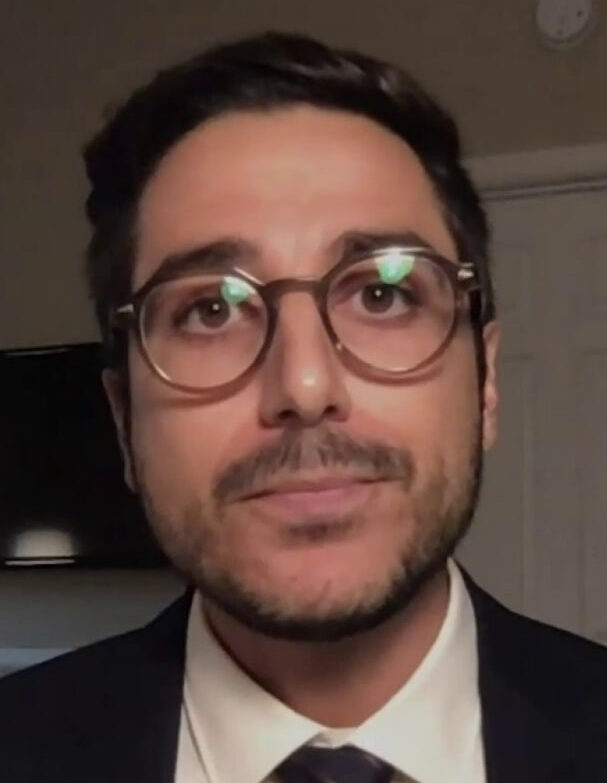 “When I first moved to the United States as an adult, I had to start filling out forms that asked about my race,” Abdallah Fayyad (pictured), an opinion writer and editorial board member at The Boston Globe, wrote Friday.
“When I first moved to the United States as an adult, I had to start filling out forms that asked about my race,” Abdallah Fayyad (pictured), an opinion writer and editorial board member at The Boston Globe, wrote Friday.
“But I didn’t really know what my race was in the American context. All I knew, having grown up in Jerusalem, was that I’m Palestinian and Arab, and that didn’t seem to fall under any of America’s five official racial categories: American Indian/Alaska Native, Native Hawaiian/Pacific Islander, white, Black, and Asian American.
“ ‘White,’ to me, meant European, and I had only ever seen or heard of Arabs referred to as ‘brown people,’ be it on American TV or in conversation. So it was to my surprise to learn that the US Census Bureau expects Arabs to check ‘white,’ which it defines as ‘a person having origins in any of the original peoples of Europe, the Middle East, or North Africa.’
“That’s an absurd definition of whiteness, especially considering the fact that there is no world in which some Arabs are actually considered white in social settings. But it turns out that the reason the census considers Americans of Middle Eastern or North African descent to be white dates back to the early 20th century, when a wave of non-European immigrants came to American shores. At the time, the United States required people to be either Black or white in order to apply for citizenship, so many non-European and non-Black immigrants — including people from the Middle East, Southeast Asia, and Eastern Asia — sought naturalization by identifying as white.”
Fayyad also wrote, “The problem is that while some Arabs may indeed identify as white, many of them do not. That’s in part because people from the Middle East and North Africa are diverse and span many complexions, and in part because Arab Americans have been distinctly targeted, surveilled, and othered, especially after 9/11. For many Arab Americans — particularly those who are Muslim — being labeled white by law simply doesn’t reflect the reality of how they’ve experienced America.
“Not counting Arabs as a separate category, be it ethnic or racial, ultimately harms Arab Americans throughout the country. . . .”
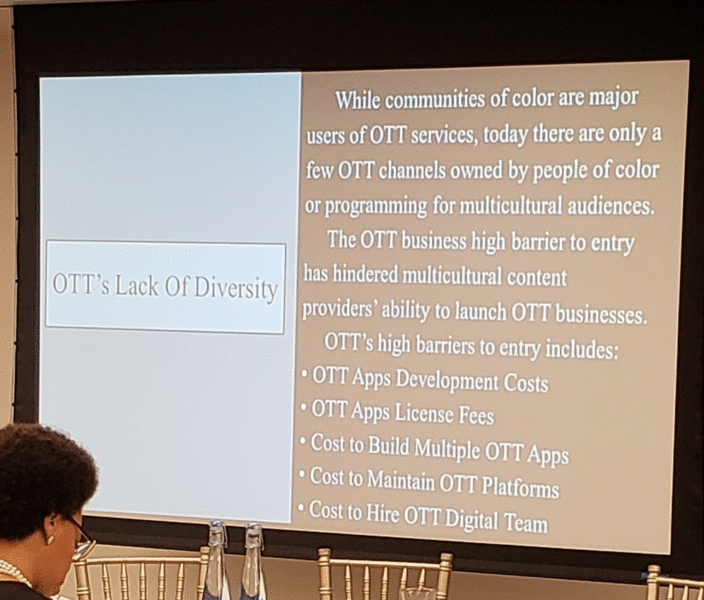
Broadcasters Say FCC’s Own Rules Limit Diversity
“The National Association of Broadcasters said Federal Communications Commission policies are a big reason there isn’t more diversity in broadcast ownership,” John Eggerton reported Friday for nexttv.com.
FCC member Geoffrey Starks reported last week, “Although the numbers show some slight improvements in majority ownership of full power commercial broadcast television stations by African Americans (up from 12 in 2017 to 18 stations in 2019), the percentage of ownership still rounds to an anemic 1%. PDF]. Moreover, that number significantly worsened for Asian American owners (from 9 full power TV stations in 2017 to four stations in 2019).”
Eggerton continued, “The broadcasting trade group shared that view in comments on the FCC’s 2018 quadrennial review of broadcast and other ownership rules (the review has been delayed due to the legal back-and-forth over that issue).
“The NAB told the commission that the FCC’s restrictions on multiple and small-market ownership are absurd and work against its goal of a more diverse media. It argues that the COVID-19 pandemic and economic recession have put an exclamation point on the need to reform the system.
“The main reason for low levels of minority and female ownership is a lack of access to capital, the NAB said, which structural ownership rules don’t address. But even if that capital were available, the FCC’s rules are a disincentive to new investment, the trade group argued. . . .
“The NAB also said the FCC’s ownership restrictions . . . prevent broadcasters in smaller markets from ‘leverag[ing] the strong economies of scale in local news production’ . . . ‘imperil[ing] the ability of news providers to reach online audiences with their local content and to derive ad revenue from that content.’ . . . ”
The National Association of Black Owned Broadcasters and the Multicultural Media, Telecom and Internet Council (MMTC) [PDF] said last week they opposed changes in the FCC’s broadcast ownership rules.
Short Takes
Exciting news for @Axios. @sarakgoo is our new editor-in-chief and @AjaWMoore is our new executive editor. My newsroom is headed by women of color. We ? @aaja @nabj https://t.co/2P2L0SyF30 pic.twitter.com/KDG8JYnjlT
— Russell Contreras (@RussContreras) September 17, 2021
Axios made the announcement on Friday.
- “Since Donald Trump was elected president in 2016 due in part to strong support from White evangelical Protestants, many observers have wondered what impact this political alliance might have on the evangelical church in the United States,” the Pew Research Center reported, summarizing findings released Wednesday. “A new analysis of survey data finds that there has been no large-scale departure from evangelicalism on the part of White Americans. In fact, there is solid evidence that White Americans who viewed Trump favorably and did not identify as evangelicals in 2016 were much more likely than White Trump skeptics to begin identifying as evangelicals by 2020.”
 “Telemundo has named Julio Vaqueiro (pictured) principal anchor of the network’s newscast,” Veronica Villafañe reported Thursday for her Media Moves site. “He makes his debut on the 6:30 pm ET/5:30 CT edition of ‘Noticias Telemundo’ on Monday, September 27. He’ll replace José Díaz-Balart, who leaves the newscast to host his own show on MSNBC and takes on a broader, yet trimmed down role within the Spanish-language network, anchoring monthly specials and major breaking news events. . . .”
“Telemundo has named Julio Vaqueiro (pictured) principal anchor of the network’s newscast,” Veronica Villafañe reported Thursday for her Media Moves site. “He makes his debut on the 6:30 pm ET/5:30 CT edition of ‘Noticias Telemundo’ on Monday, September 27. He’ll replace José Díaz-Balart, who leaves the newscast to host his own show on MSNBC and takes on a broader, yet trimmed down role within the Spanish-language network, anchoring monthly specials and major breaking news events. . . .”
- “ ‘Unapologetic’ has become a mantra for Black people across the country for reclaiming Black culture and being proud of it,” Najja Parker wrote Wednesday for the Atlanta Journal-Constitution. “Every Thursday, our team of writers, photographers and videographers will keep you informed of the latest and most important news about Black topics. We’re kicking off our first edition by introducing you to our co-hosts — lifestyle columnist Nedra Rhone and race and culture reporter Ernie Suggs. . . .”
- For all the power that television creators such as Shonda Rhimes and Kenya Barris have achieved, “the power in the television industry still rests mostly in the hands of white executives,” Hannah Giorgis wrote Monday for The Atlantic. UCLA’s 2020 “Hollywood Diversity Report,” an annual study of the entertainment industry’s progress, or lack of it, “revealed that less than 11 percent of broadcast scripted-show creators, less than 15 percent of cable scripted-show creators, and less than 11 percent of digital scripted-show creators come from any underrepresented racial group. (These groups, taken together, make up roughly 40 percent of the U.S. population.) . . .”
- “ViacomCBS is formally launching BET Studios, which will offer Black creatives an equity stake and a place to produce for outlets within and outside the media conglomerate,” Rick Porter wrote Wednesday for The Hollywood Reporter. “Kenya Barris — who left a nine-figure Netflix deal for a stake in the venture — Rashida Jones and SWAT co-creator Aaron Rahsaan Thomas will be principal partners in BET Studios. Former Warner Bros. TV executive Aisha Summers Burke will head the studio as executive vp and general manager. . . .”
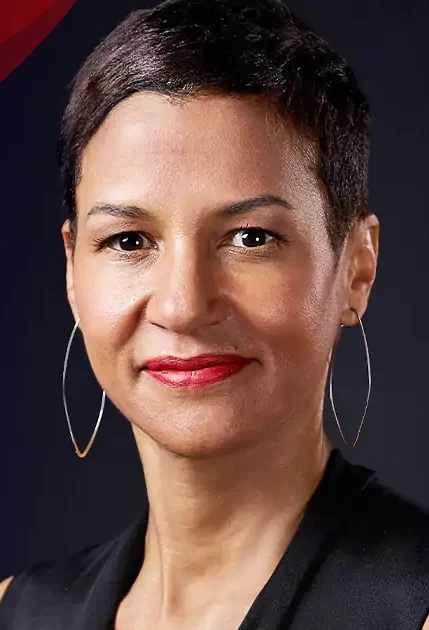 A new HBO Max initiative, Scene in Black, “will serve as a dedicated social destination to promote and support the telling of stories from the Black perspective,“ Luz Corona reported Wednesday for Adweek. “The initiative will support the brand’s efforts in diverse and timely storytelling by highlighting the [African American]-focused programming on the HBO Max platform.” Jackie Gagne (pictured) “leads the strategy and development of marketing initiatives to connect Black, Latinx, AAPI and LGBTQ+ audiences to their programming. . . .”
A new HBO Max initiative, Scene in Black, “will serve as a dedicated social destination to promote and support the telling of stories from the Black perspective,“ Luz Corona reported Wednesday for Adweek. “The initiative will support the brand’s efforts in diverse and timely storytelling by highlighting the [African American]-focused programming on the HBO Max platform.” Jackie Gagne (pictured) “leads the strategy and development of marketing initiatives to connect Black, Latinx, AAPI and LGBTQ+ audiences to their programming. . . .”
- The National Association of Broadcasters has launched a series of new commercials for stations to air that underscore the importance of fact-based journalism,” NAB said Thursday, “at a time when misinformation is running rampant on social media. Listen to or download the commercials HERE.”
- “The Corporation for Public Broadcasting (CPB) announced grants totaling $1.3 million for three public radio stations to implement the Urban Alternative format to connect with young, multicultural audiences,” CPB announced Tuesday. “The grants to Radio Milwaukee, WJSU (Jackson, MS), and Minnesota Public Radio will support transitions to locally customized formats using local and national Hip Hop and R&B. Jacquie Gales Webb, CPB Vice President, Radio, announced the grants today at the virtual Public Radio Program Directors Conference. . . .”
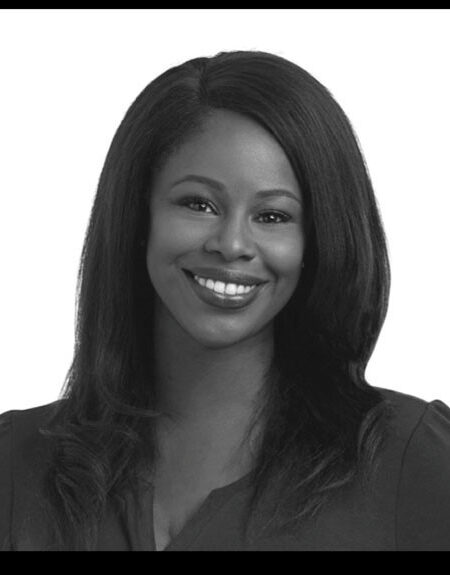 “I am very proud that ABC News had one of the most diverse broadcast teams covering the last presidential election,” said Averi Harper (pictured), 30, appointed ABC News deputy political director in March. “And because of that,” Harper told Alexandria Neason of Columbia Journalism Review, “we were able to kind of pool our ideas and figure out: What are the questions that I should be asking, that I know that my colleagues at the other large networks are not going to be doing? For me specifically, in the coverage of Kamala Harris — Kamala Harris is the daughter of a Jamaican immigrant. I am from the West Indies. My mother is from Jamaica. My father is from Trinidad and Tobago. And so I leaned into that specialized knowledge that I knew that no one else who was covering her had, to generate stories, to generate content, and to put out some understanding about where she comes from and why she might appeal to different segments of the electorate. . . .”
“I am very proud that ABC News had one of the most diverse broadcast teams covering the last presidential election,” said Averi Harper (pictured), 30, appointed ABC News deputy political director in March. “And because of that,” Harper told Alexandria Neason of Columbia Journalism Review, “we were able to kind of pool our ideas and figure out: What are the questions that I should be asking, that I know that my colleagues at the other large networks are not going to be doing? For me specifically, in the coverage of Kamala Harris — Kamala Harris is the daughter of a Jamaican immigrant. I am from the West Indies. My mother is from Jamaica. My father is from Trinidad and Tobago. And so I leaned into that specialized knowledge that I knew that no one else who was covering her had, to generate stories, to generate content, and to put out some understanding about where she comes from and why she might appeal to different segments of the electorate. . . .”
- As July closed, Wired senior writer Jason Parham published a three-part oral history called “A People’s History of Black Twitter.” A key moment came with the June 25, 2009, death of Michael Jackson. Brandon Jenkins, TV and podcast host, said, “It took ABC News at least an hour before his passing came across the news ticker in Times Square. I remember thinking, ‘Damn, Twitter broke this news.’ ” Kozza Babumba, head of social at the music lyric-focused website Genius, said, “I remember being like, ‘Can news travel that fast? Can you literally get news before the news? Can you be the news?’ That’s what it was.” Jamilah Lemieux, Slate columnist, added, “It changed who we look to for news.”
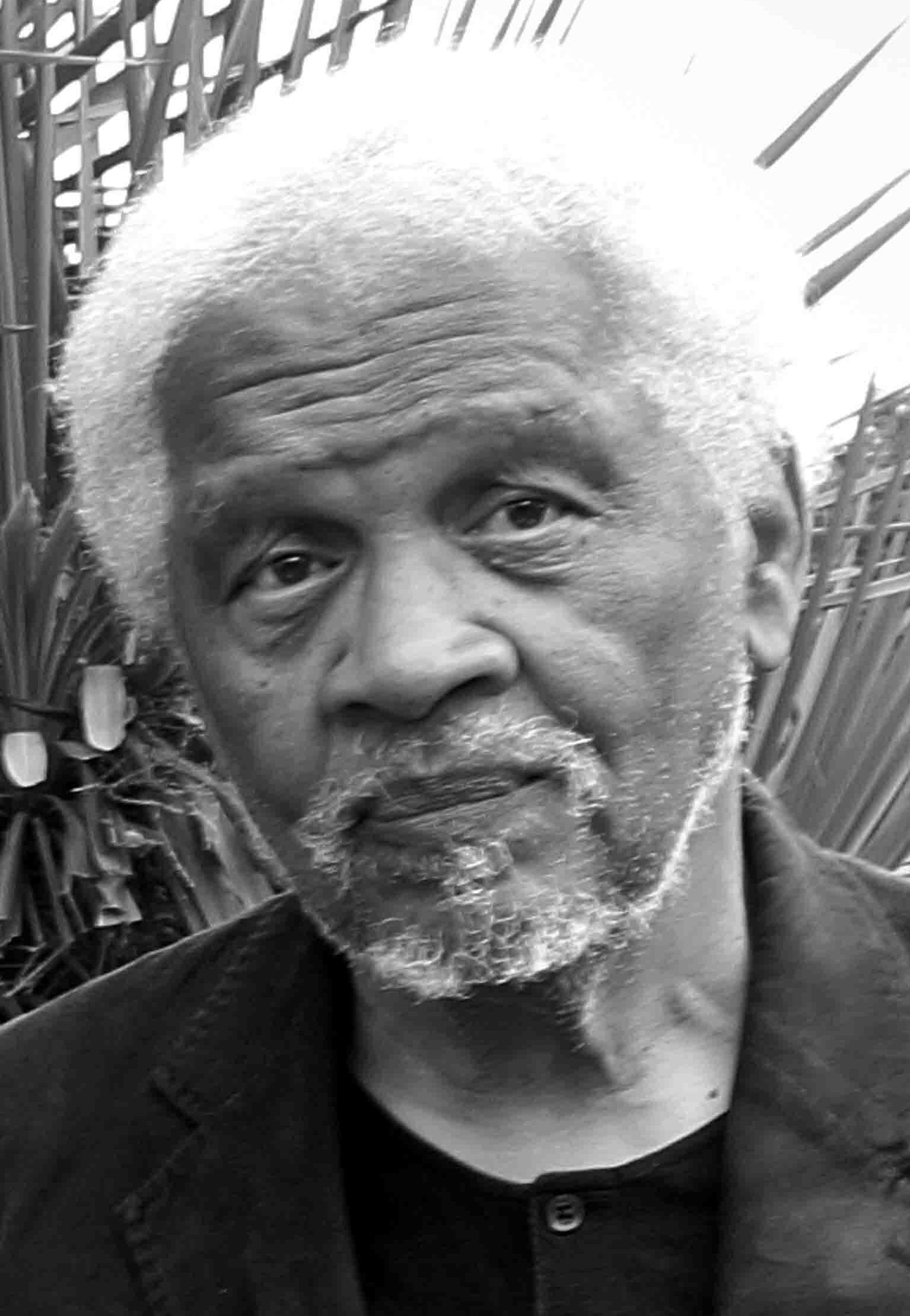 New York Times “columnists — who occupy the Olympus of punditry, from where they scold Blacks and issue moral pronouncements — have been on a binge of California hating, Oakland-based novelist and essayist Ishmael Reed (pictured) wrote Sept. 8 for Alta. “Some of them seem more concerned about a cultural war, which they view as having been launched by Blacks from their base in San Francisco —- wokeness, critical theory, political correctness, and cancel culture are shorthand for Blacks — than the Trump followers who attempted a coup against the United States. Indeed, some even make excuses for these vandals. . . .”
New York Times “columnists — who occupy the Olympus of punditry, from where they scold Blacks and issue moral pronouncements — have been on a binge of California hating, Oakland-based novelist and essayist Ishmael Reed (pictured) wrote Sept. 8 for Alta. “Some of them seem more concerned about a cultural war, which they view as having been launched by Blacks from their base in San Francisco —- wokeness, critical theory, political correctness, and cancel culture are shorthand for Blacks — than the Trump followers who attempted a coup against the United States. Indeed, some even make excuses for these vandals. . . .”
- A statue of the journalist and activist Ida B. Wells was unveiled Thursday at Washington, D.C. middle school named for her. NPR’s Noel King interviewed Michelle Duster, Wells’ great-granddaughter. Wells co-founded the National Association of Colored Women’s Clubs in the city in 1896 and participated in a suffrage march there in 1913. The sculptor is Ai Qiu Hopen, who specializes in memorials.
- “No place has played a more central role in the creation of residential segregation than Los Angeles,” Gene Slater reported Sept. 8 for the Los Angeles Times. “With its fast-growing subdivisions and enormous real estate industry, the city shaped the divided neighborhoods and political arguments that drive America today. . . . As the country’s fastest growing market, L.A. became the model — not just for restricting individual tracts but whole new suburbs. Realtors conspired with local officials to require covenants on all subdivisions in Glendale so that only one African American owned property there. Ads in the Los Angeles Times in 1925 boasted that ‘the residents of Eagle Rock are all of the white race.’ . . .”
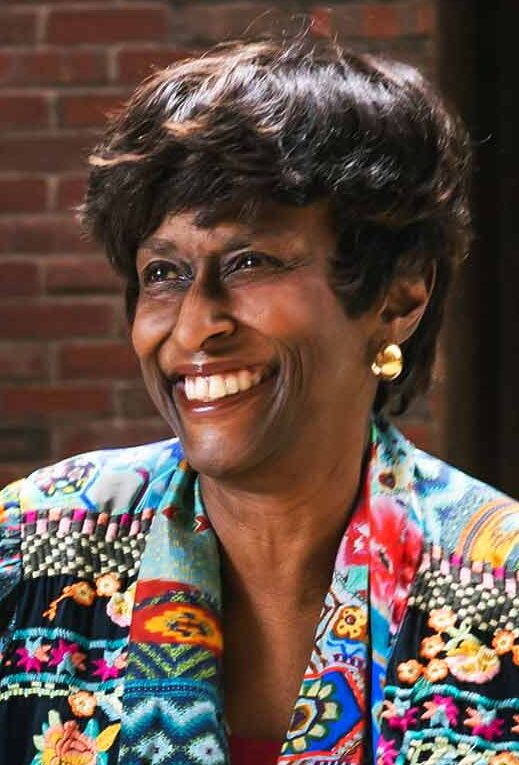 “Carmen Fields (pictured) was in the vanguard of Black women journalists who propelled the long, slow struggle to diversify America’s newsrooms, and in the process, change how communities of color are reported on and seen,” Sara Rimer wrote Wednesday for a q-and-a in Bostonia, Boston University’s alumni magazine. “In 1973, she became one of only two female Black reporters in a Boston Globe newsroom dominated by white men. . . . The 100th anniversary of the 1921 Tulsa race massacre last spring brought renewed attention to one of her crowning journalistic achievements — the 1993 PBS American Experience documentary Going Back to T-Town . . .”
“Carmen Fields (pictured) was in the vanguard of Black women journalists who propelled the long, slow struggle to diversify America’s newsrooms, and in the process, change how communities of color are reported on and seen,” Sara Rimer wrote Wednesday for a q-and-a in Bostonia, Boston University’s alumni magazine. “In 1973, she became one of only two female Black reporters in a Boston Globe newsroom dominated by white men. . . . The 100th anniversary of the 1921 Tulsa race massacre last spring brought renewed attention to one of her crowning journalistic achievements — the 1993 PBS American Experience documentary Going Back to T-Town . . .”
 Gillian B. White (pictured), deputy editor at The Atlantic, is joining the Capital B startup as senior vice president of revenue and programming, Lauren Williams, co-founder and CEO, announced Tuesday on Twitter. Capital B is a a nonprofit news organization to be focused on local journalism and Black communities.
Gillian B. White (pictured), deputy editor at The Atlantic, is joining the Capital B startup as senior vice president of revenue and programming, Lauren Williams, co-founder and CEO, announced Tuesday on Twitter. Capital B is a a nonprofit news organization to be focused on local journalism and Black communities.
- “If CBS’ upcoming series ‘The Activist’ was meant to showcase the power of people to effect change through social media, then it makes sense that it would be majorly overhauled after widespread online backlash,” Cole Delbyck wrote Thursday for HuffPost. “The network has announced that the yet-to-air reality competition series, which pitted six activists against each other vying to make a difference in health, education or the environment, will be retooled as a prime time documentary special. . . .”

Brazilian freelance photographer Tuca Vieira’s 2004 image of the sharp divide between the Paraisópolis favela and opulent apartments in São Paulo’s Morumbi suburb, taken from a helicopter. (Credit: Courtesy of Tuca Vieira, via Global Investigative Network)
- “Aerial photography has emerged as one of the most powerful approaches to uncovering the chasm of wealth and resources between communities,” Rowan Philp wrote Thursday for the Global Investigative Network. He offered “Tips for Reporters Seeking to Reveal the Scale of Inequality,” including graphic and visualization tools. “It is clear that inequality has become one of the issues of our day, fueling political movements, calls for change, and attempts to level the playing field around the world,” Philp wrote.
 “If you follow news from Africa, you have no doubt seen Lynsey Chutel’s (pictured) byline,” New York Times editors wrote staffers on Thursday. “She founded the Africa Desk at News24, one of South Africa’s largest news outlets, where she was also its lead writer. Her Africa Brief newsletter for Foreign Policy magazine landed in email inboxes each week. As a stringer for The New York Times, she filed a stream of stories including breaking news and enterprise. Now, Lynsey — who somehow managed to keep all of those plates spinning at the same time — will consolidate her prodigious talents under one tent, as a reporter-researcher in our Johannesburg bureau. . . .”
“If you follow news from Africa, you have no doubt seen Lynsey Chutel’s (pictured) byline,” New York Times editors wrote staffers on Thursday. “She founded the Africa Desk at News24, one of South Africa’s largest news outlets, where she was also its lead writer. Her Africa Brief newsletter for Foreign Policy magazine landed in email inboxes each week. As a stringer for The New York Times, she filed a stream of stories including breaking news and enterprise. Now, Lynsey — who somehow managed to keep all of those plates spinning at the same time — will consolidate her prodigious talents under one tent, as a reporter-researcher in our Johannesburg bureau. . . .”
- “Police beat a journalist and fired tear gas to disperse a small crowd in Democratic Republic of Congo’s capital Kinshasa on Wednesday during an opposition protest over alleged election meddling, eyewitnesses said,” Hereward Holland reported Wednesday for Reuters. “Around 20 protesters gathered in response to a call by opposition leader Martin Fayulu and were met with stiff resistance from police. Police beat and temporarily detained Patient Ligodi, a journalist working for Radio France International, while he was interviewing Fayulu. . . .”
- “Following the addition of two more names to the list of 54 journalists and media workers currently held in the military junta’s jails in Myanmar,” Reporters Without Borders (RSF) said Thursday, “reminds the international community of the need for targeted sanctions against those responsible for the growing terror. Mizzima News former editor-in-chief Myo Thant was arrested yesterday in Kangye Htaung, a township in southwestern Myanmar’s Irrawaddy River delta region. RSF has learned that the security forces went to the township after being told he was there, and threatened to take his aunt if he did not surrender. He was finally arrested at round 8 pm. . . .”
To subscribe at no cost, please send an email to journal-isms+subscribe@groups.io and say who you are.
Facebook users: “Like” “Richard Prince’s Journal-isms” on Facebook.
Follow Richard Prince on Twitter @princeeditor
Richard Prince’s Journal-isms originates from Washington. It began in print before most of us knew what the internet was, and it would like to be referred to as a “column.” Any views expressed in the column are those of the person or organization quoted and not those of any other entity. Send tips, comments and concerns to Richard Prince at journal-isms+owner@
View previous columns (after Feb. 13, 2016).
View previous columns (before Feb. 13, 2016)
-
-
- Diversity’s Greatest Hits, 2018 (Jan. 4, 2019)
- Book Notes: Is Taking a Knee Really All That? (Dec. 20, 2018)
- Book Notes: Challenging ’45’ and Proudly Telling the Story (Dec. 18, 2018)
- Book Notes: Get Down With the Legends! (Dec. 11, 2018)
- Journalist Richard Prince w/Joe Madison (Sirius XM, April 18, 2018) (podcast)
- Richard Prince (journalist) (Wikipedia entry)
- February 2018 Podcast: Richard “Dick” Prince on the need for newsroom diversity (Gabriel Greschler, Student Press Law Center, Feb. 26, 2018)
- Diversity’s Greatest Hits, 2017 — Where Will They Take Us in the Year Ahead?
- Book Notes: Best Sellers, Uncovered Treasures, Overlooked History (Dec. 19, 2017)
- An advocate for diversity in the media is still pressing for representation, (Courtland Milloy, Washington Post, Nov. 28, 2017)
- Morgan Global Journalism Review: Journal-isms Journeys On (Aug. 31, 2017)
- Diversity’s Greatest Hits, 2016
- Book Notes: 16 Writers Dish About ‘Chelle,’ the First Lady
- Book Notes: From Coretta to Barack, and in Search of the Godfather
- Journal-isms’ Richard Prince Wants Your Ideas (FishbowlDC, Feb. 26, 2016)
- “JOURNAL-ISMS” IS LATEST TO BEAR BRUNT OF INDUSTRY’S ECONOMIC WOES (Feb. 19, 2016)
- Richard Prince with Charlayne Hunter-Gault,“PBS NewsHour,” “What stagnant diversity means for America’s newsrooms” (Dec. 15, 2015)
- Book Notes: Journalists Follow Their Passions
- Book Notes: Journalists Who Rocked Their World
- Book Notes: Hands Up! Read This!
- Book Notes: New Cosby Bio Looks Like a Best-Seller
- Journo-diversity advocate turns attention to Ezra Klein project (Erik Wemple, Washington Post, March 5, 2014)
-
When you shop @AmazonSmile, Amazon will make a donation to Journal-Isms Inc. https://t.co/OFkE3Gu0eK
— Richard Prince (@princeeditor) March 16, 2018

